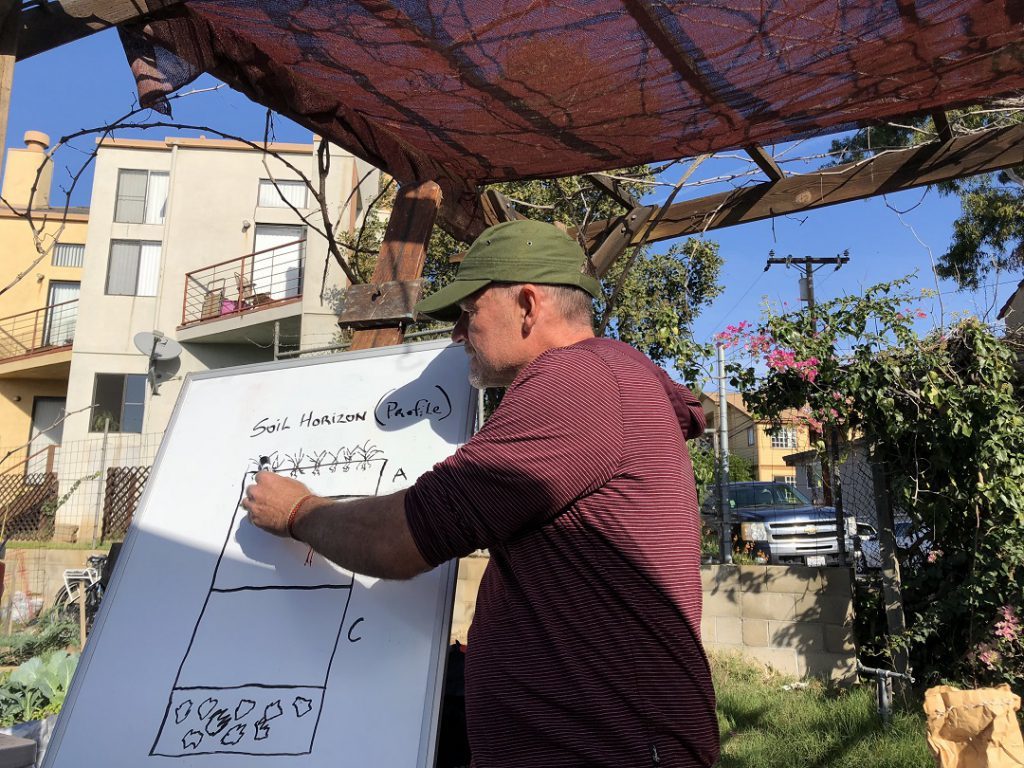LBO Workshop: Building Better Soil
When Long Beach Organic was establishing its Charity Garden at the Zaferia Junction Community Garden, the clay was so hard that it was even a challenge for a team of volunteer college men with pickaxes. They were only able to break through a few inches. Now, six years later, the soil is rich, delivering crop after crop of vegetables to needy residents.
 Master gardener Ken Yliniemi explains the components of soil. Such is the power of soil-building. On Saturday, master gardener Ken Yliniemi explained the components of soil and how to generate nutrient-rich humus to give your plants what they need to flourish.
Master gardener Ken Yliniemi explains the components of soil. Such is the power of soil-building. On Saturday, master gardener Ken Yliniemi explained the components of soil and how to generate nutrient-rich humus to give your plants what they need to flourish.
“I really get excited about soil,” said Yliniemi. “Having good soil in your garden is amazing.”
To begin with, it’s important to understand your soil profile. The topsoil, which contains minerals and organic material, can be as thin as 1 inch or as deep as 8 inches. In the Midwest, the prairie grass ecosystem has created a thick layer of rich topsoil. However, there’s much less topsoil in the West, where much of the land is former lake beds.
Below the topsoil is the subsoil, which can sometimes be overlooked. “Some of the roots will extend down to the subsoil,” said Yliniemi, adding that it’s important that the subsoil contain minerals the plants need to grow.
Below the subsoil is the eluviated layer, which usually contains a concentration of sand and silt particles. And below that is the bedrock, which can be many feet down.
There are three types of soil:
Silt—Although it holds moisture well and is highly fertile, the fine particles of silt are prone to washing away.
Sand—Light, warm, and dry, sand tends to be acidic, doesn’t hold moisture, and is low in nutrients.
Clay—Although high in nutrients, clay tends to hold moisture and dry out in summer.
Your garden soil may be a combination of the three. Yliniemi recommends breaking apart your soil to determine how much of each it contains. Ideally, sand, clay, and silt can be combined to make loam, a soil that’s fertile, easy to work with, and drains well.
“That’s what you want in your garden—a good loam. It’s a living organism and it has a lot of components to it—and some you don’t even know are there,” he said.
 Adding organics such as peat, compost, manure, green manure, worm castings, bacteria, and fungi can create a soil that has good structure, soaks up and holds moisture, flows oxygen to the roots of plants, and provides a continual supply of nutrients and minerals.
Adding organics such as peat, compost, manure, green manure, worm castings, bacteria, and fungi can create a soil that has good structure, soaks up and holds moisture, flows oxygen to the roots of plants, and provides a continual supply of nutrients and minerals.
Compost is ideal to add, since it’s already decomposed and, unlike wood chips, won’t rob plants of their nitrogen. Manure is another good source of organic material, although too much may lead to a buildup of ammonia. Steer, horse, and chicken manure are all fine to use, since those animals don’t spread disease to humans. That’s not the case with dog and cat droppings, however.
Yliniemi is a proponent of green manure for soil building, which involves planting cover crops such as buckwheat, annual grasses, clover, or legumes, then turning them into the soil to decompose for about six weeks.
“If you don’t know what to plant in the winter, plant a cover crop. Your garden will thank you in the spring,” he said. “When you plant, you’ve got all those nutrients immediately available.”
Soil needs macronutrients—nitrogen, phosphorous, potassium, sulfur, calcium, and magnesium—as well as micronutrients—chlorine, iron, boron, manganese, zinc, copper, molybdenum.
Soil pH is also important. pH levels range from 0-14, with 7 being neutral, below 7 acidic, and above 7 alkaline. California soils are usually 6.5-8. Soil can be made more acidic by adding coffee grounds, peat moss, vinegar, pine needles, shredded evergreen bark or composted tree leaves. Be careful not to add too much coffee grounds, Yliniemi warns, since even a small quantity can turn the soil quickly acidic.
Encouraging bacteria and fungi is another way to ensure your plants thrive. For example, you can add rhizobium to seeds during planting to encourage nitrogen uptake. Fungi can also grow on roots to help with nutrient absorbtion.
If you want to know more about your soil, Yliniemi recommends using an electronic soil tester to measure Ph and nutrients. It’s quicker and cheaper than sending a soil sample to a laboratory.
Keeping soil at the optimum temperature is another thing that gardeners can do to keep plants happy. The perfect temperature is 65 degrees; below 55 and above 90, most seeds won’t germinate. You can use mulch or straw to keep soil temperatures from being too warm.
- Margo McCall